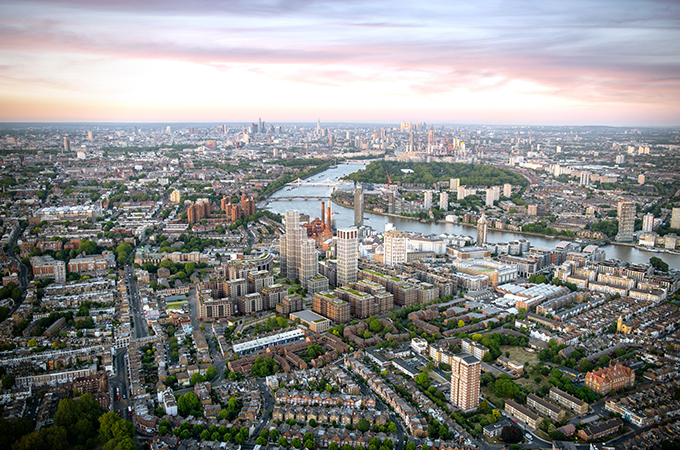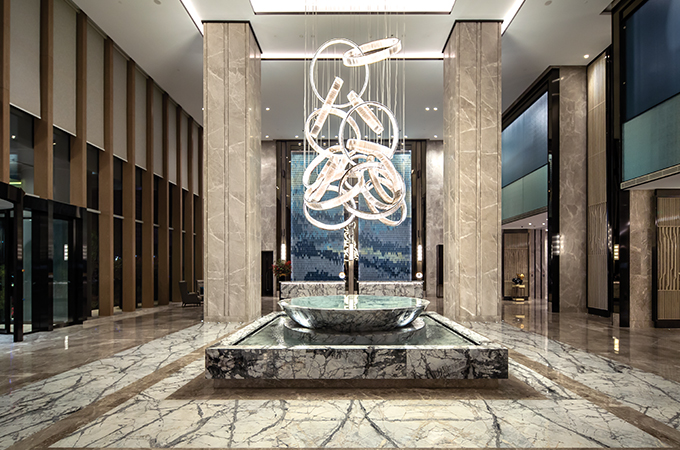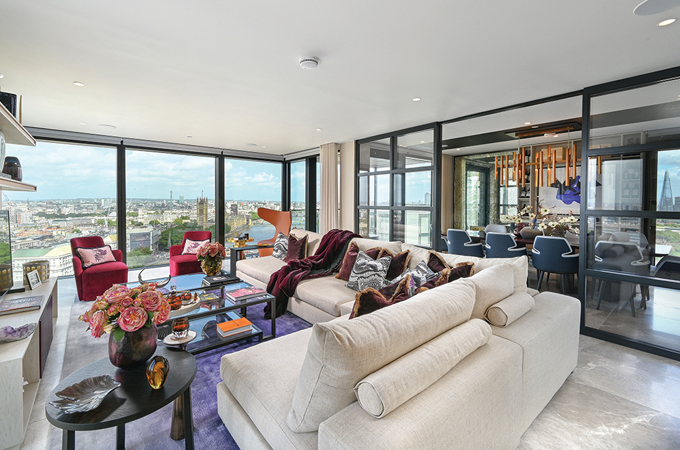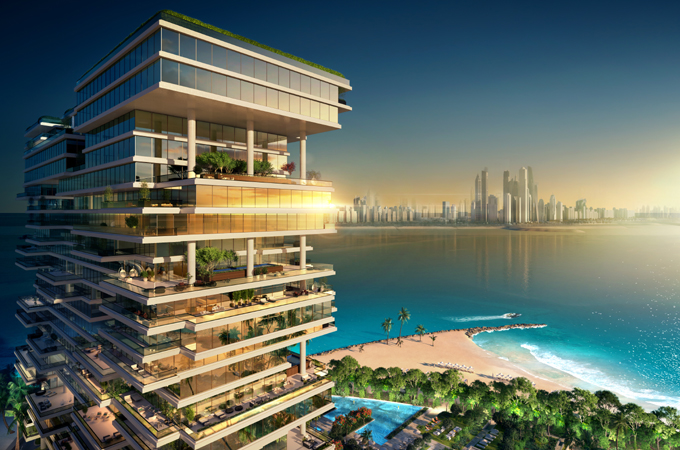Thu, Dec 1, 2016
The magnificent Grade II listed Oceanic House at 1 Cockspur Street, by Trafalgar Square, originally the London headquarters and ticket office of the famous White Star Line, has been transformed into the capital’s most iconic luxury apartment address.
The former headquarters building for the glamorous Titanic and Olympic ocean liners, has been sensitively redeveloped to provide six luxurious lateral apartments and one two-storey penthouse for private sale. The beautiful apartments benefit from large spacious rooms, good ceiling heights and range from 1,679 sq ft (156 sq m) to 5,447 sq ft (506 sq m) in size. Each are bespoke designed with a specification and features specially created to echo the luxury associated with the turn-of-the-century age of transatlantic ocean travel.
The restoration of Oceanic House opens the door to the history of the famous White Star Line, and provides a fresh insight into the ambitions of Chairman Bruce Ismay and events surrounding the Titanic. Founded in 1845 as a UK-Australia shipping firm by John Pilkington and Henry Wilson, in 1868 the White Star Line was purchased by Thomas Henry Ismay (1837-1899) and transformed into a North-Atlantic ocean liner business with the ships (from 1870) constructed by Belfast firm Harland & Wolff, headed by Sir Edward Harland. In 1896-1898 the White Star Line built offices in Liverpool, known as Albion House, on James Street.
In 1895 Sir Edward Harland died, followed in 1899 by Thomas Henry Ismay; the latter succeeded by his son Joseph “Bruce” Ismay (1862-1937). The partnership between Bruce Ismay and new Harland & Wolff chairman Lord William Pirrie, brought in a new management style and vision to create the world’s most successful and luxurious ocean liner business.
To fund these ambitions, in 1902 Bruce Ismay sold the White Star Line to American multi-millionaire John Pierpont Morgan; with Ismay remaining as Chairman. The sale provided money which Ismay lavished on a London headquarters building and a fleet of ocean liners. Oceanic House, located on a landmark site at 1 Cockspur Street was built between 1903 and 1906 as the London headquarters of the White Star Line.
Constructed of Portland stone in a grand Neo-classical style typical of Edwardian era buildings in and around Whitehall, Oceanic House has a monumental central doorway, flanked by a dramatic three-storey engaged column portico complete Baroque inspired detailing.
Oceanic House was designed by architect Henry Tanner Junior under the auspices of Bruce Ismay with the address being highly symbolic since at the time all the major liner and train company HQs were based on Cockspur Street including rival Cunard, Hamburg-American Line, Peninsular & Oriental (P&O), The Grand Trunk Railway and the Canadian National Railway Company.
The ground floor of Oceanic House served as the booking office for wealthy first class and other passengers, with the basement providing luggage rooms where trunks could be stored and transferred to passenger’s cabins ready for their arrival on-board. It was from Oceanic House that the Countess of Rothes, Sir Cosmo Duff-Gordon and Lucy, Lady Duff-Gordon purchased their First Class tickets to travel on the Titanic. The first floor rooms were for the White Star Line board of directors where they met bankers, clients, journalists and suppliers. The upper floors served as administrative offices.
With the London headquarters completed, in early 1907 the White Star Line moved their transatlantic service from Liverpool to Southampton, because it was more convenient for London passengers and just a short crossing to Cherbourg for continental trade. Bruce and his wife Florence, relocated from their home at Mossley Hill in Liverpool to a new rented home at 27 Chesham Street in Belgravia, later purchasing in 1909 a house at 15 Hill Street in Mayfair.
In July 1907 at a party at the 24 Belgrave Square home (now Spanish Embassy) of Lord Pirrie of Harland & Wolff, Ismay and Pirrie sketched out plans for the largest liners the world had ever seen – Titanic, Olympic and Britannic. Meetings with Thomas Andrews (1873-1912), architect of the Titanic and its sisters, followed and it was from Oceanic House that Ismay ordered the reduction in lifeboats on the Titanic and Olympic from 48 to just 16, the minimum allowed under safety standards.
Sea trials for Titanic began on April 2, 2012, and in the boardroom at Oceanic House Ismay boasted to journalists that Titanic was “unsinkable”. Fatefully Ismay also said that Titanic might arrive in New York early on its maiden voyage, on the evening of 16th April, in time to gain stories in the next day’s papers.
On April 10, 1912 Titanic’s maiden voyage began from Southampton, scheduled to arrive in New York on the early morning of 17th April 1912. Confident that Titanic was unsinkable, no lifeboat drill was carried out, and mindful of the papers, Ismay pressed Captain Edward Smith to sail at full speed, despite warnings of icebergs.
At 11.40 pm on April 14 the Titanic struck an iceberg and just before midnight Ismay escaped in lifeboat C; however ship’s architect, Thomas Andrews, and Captain, Edward Smith, along with a total of 1,517 people died due to the disaster.
After news of Titanic’s fate reached shore the most iconic image associated with the disaster was snapped outside Oceanic House. Taken on 16 April 1912, it shows 16 year old newsboy Ned Parfett clutching an Evening News poster about the great loss of life.
Ismay returned from New York to Oceanic House to find the building protected by police and surrounded by protestors and the world’s media, with inside queues scanning the Titanic passenger and crew list in the ticket office. Called “the coward of the Titanic” and “Brute Ismay” by the media, on June 13, 1913 Ismay resigned as Chairman of the White Star, succeeded by Harold Sanderson under whose stewardship the Olympic and other liners became successful commercial ventures.
In 1927 the White Star Line was purchased by the Royal Mail Steam Packet Company (RMSPC). Oceanic House remained the White Star Line headquarters until in 1929 when it was relocated to Leadenhall Street where the RMSPC was based; finally in 1934 the White Star Line was merged with rival Cunard.
Oceanic House then became the London regional offices of Barclays Bank; later offices of the Ministry of Defence. Finally in the 1990s it became the Texas Embassy, a restaurant and promotional centre for the State of Texas, its glorious White Star Line origins long forgotten and submerged.
In 2012 Misland Capital Ltd, on behalf of their client, purchased the Crown Estate lease for Oceanic House. Misland Capital subsequently obtained a lease extension and planning approval and, in late 2014, initiated the re-development of Oceanic House into seven luxurious apartments with grand ground floor entrance foyer and two retail units. Since then, Misland Capital has overseen the project working with Oceanic Developments Ltd towards completing the scheme to the highest standards of design and construction.
Creating an exciting new future for the historic building, Oceanic Developments Ltd are proud to bring to market a restored and converted Oceanic House, now transformed into a prestigious and exclusive residential address.
Construction has been undertaken by multi-award winning contractor Ellmer Construction Ltd, part of luxury development specialists the Byrne Group, with interior architecture by globally renowned architects BLDA, designed in a style recalling the abundant luxury synonymous with transatlantic ocean liners.
The Grade II listed exterior of Oceanic House has been carefully restored, including (110 years after the original creation), a newly restored pedimented arch and balustrade crowning the building’s main entrance. Inside, the grand interior has been remodelled to provide two three-bedroom apartments, four two-bedroom apartments, and a four bedroom duplex penthouse, extending across the two top floors; each apartment accessed by a lift from the entrance hall.
With 24-hour security, underfloor heating, spacious reception rooms and ensuites to every bedroom, the new apartments in Oceanic House combine its rich historical association with the most desirable of modern features, bespoke design and luxurious finishes and fittings.
The building’s ground floor main entrance foyer has been carefully remodelled to evoke the glamour of the early twentieth century ocean liners with special reference to the most luxurious of them all, the Titanic, in the form of a scale model of the liner on display.
Two original, renovated European oak doors mark the transition from the restored exterior to the sumptuous new interior, which, with its 18+ foot (5.5 metre) high ceilings and area of seating where residents can meet visitors, is as dramatic and exquisite as the original First Class booking office. The grand entrance hall features parquet flooring with stone borders, full height panelling and details such as profiled timber pilasters and dado rails, all inspired by the original Edwardian design. The 24 hour concierge will provide a warm welcome and a lifestyle management service for residents.
An inter-connecting suite of reception rooms in the tradition of grand Edwardian salons inspires the layout of each of the beautiful apartments. Oak engineered parquet flooring, cornices, coffered ceilings and wall panelling in selected areas all feature in keeping with the classical architecture of this landmark building.
The bespoke fully fitted kitchens feature Poggenpohl furniture with Slitstone worktops and toughened glass splashbacks. All the bedrooms have ensuites, while the larger master bedrooms have both ‘his’ and ‘hers’ bathrooms, furnished with Carrara or Nero Marquina marble panel wall slabs and stone or ceramic flooring. All the apartments and duplex penthouse benefit from underfloor heating and comfort cooling.
The spectacular two storey penthouse is located accross the fifth and sixth floors, with a grand galleried entrance hallway, beautifully illuminated by a skylight above. The penthouse features generously-sized reception rooms, four spacious bedrooms, five bathrooms and two roof terraces.
Gary Hersham, Partner at Beauchamp Estates said: “The apartments at Oceanic House represent a unique, once-in-a-lifetime, opportunity to purchase a piece of iconic British history and acquire a luxurious home in the former headquarters of the famous White Star Line in the heart of London’s West End.”
Paul Finch, Head of New Homes Sales at Beauchamp Estates said: “Oceanic House sits within the Trafalagar Square “crossroads” where Whitehall, the Strand, Covent Garden and Pall Mall/St James’s meet. Whitehall, the heart of UK government; adjacent St James’s and the Strand/Covent Garden are undergoing transformation into a luxury residential and hotel destination. The location is adjacent to Mayfair and Belgravia, but without the corresponding peaks in residential values. Purchasers at Oceanic House have the benefit of buying into a formerly overlooked location which is now undergoing rapid transformation into a luxury residential address, with the associated capital value uplift that occurs with regeneration and huge inward investment.”
Prices at Oceanic House start from £5,265,000 ($6,569,770) for a two-bedroom apartment.























